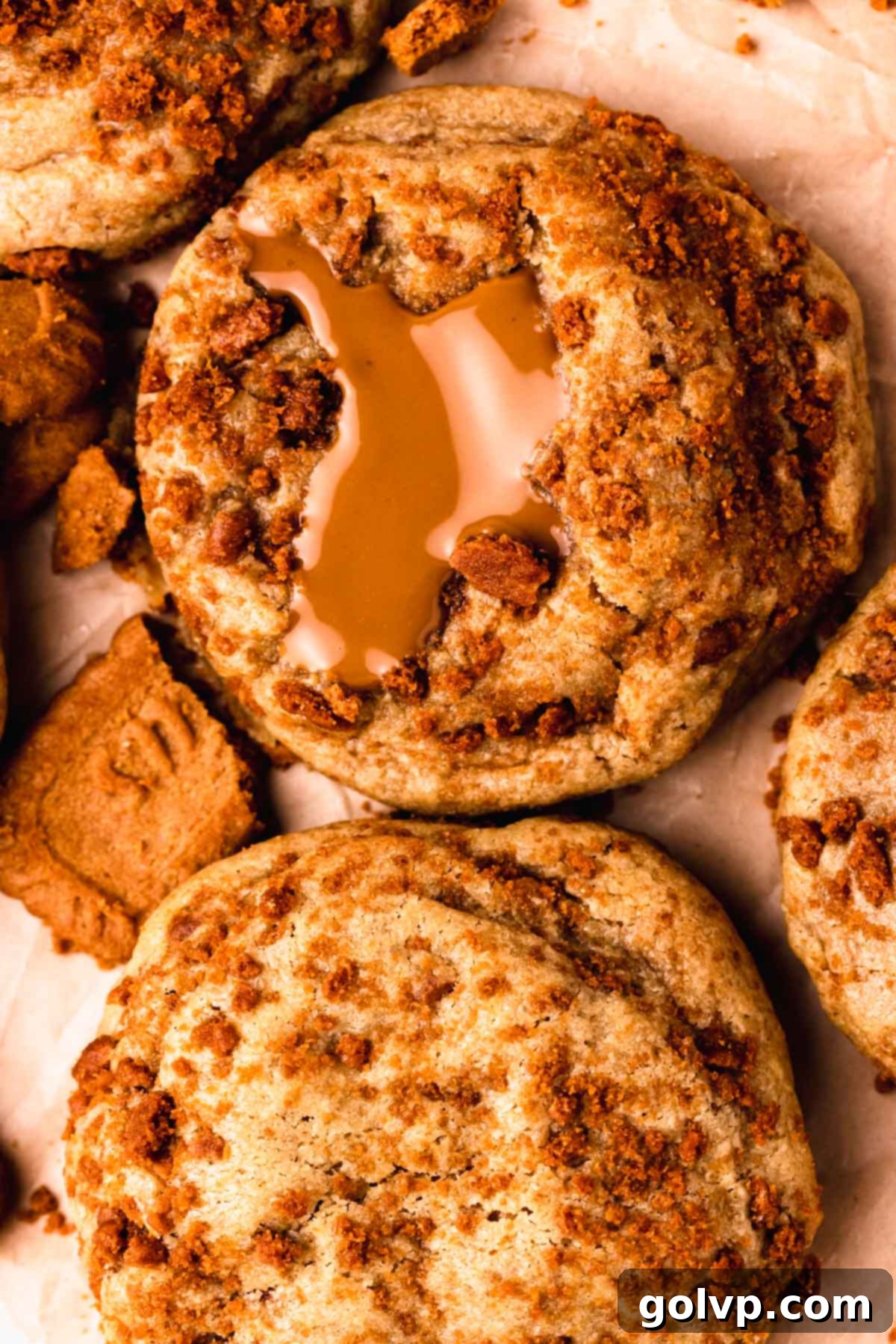Indulge in Ultimate Gooey Perfection: Bakery-Style Biscoff Stuffed Cookies
Prepare to be utterly captivated by these extraordinary Biscoff Stuffed Cookies, a true masterpiece for any dessert enthusiast. Imagine a thick, unbelievably soft, and gloriously chewy cookie, generously packed with a molten core of creamy Biscoff cookie butter and delightful chunks of caramelized Biscoff biscuits. These aren’t just cookies; they’re an experience, designed to bring the indulgent flavors of your favorite bakery right into your home kitchen. Every bite delivers a symphony of warming cinnamon, rich caramel, and a texture that’s simultaneously crisp on the edges and wonderfully gooey in the center. If you adore the unique taste of Lotus Biscoff, this recipe promises to be your new obsession, offering the ultimate, over-the-top cookie butter treat that will leave you craving more.
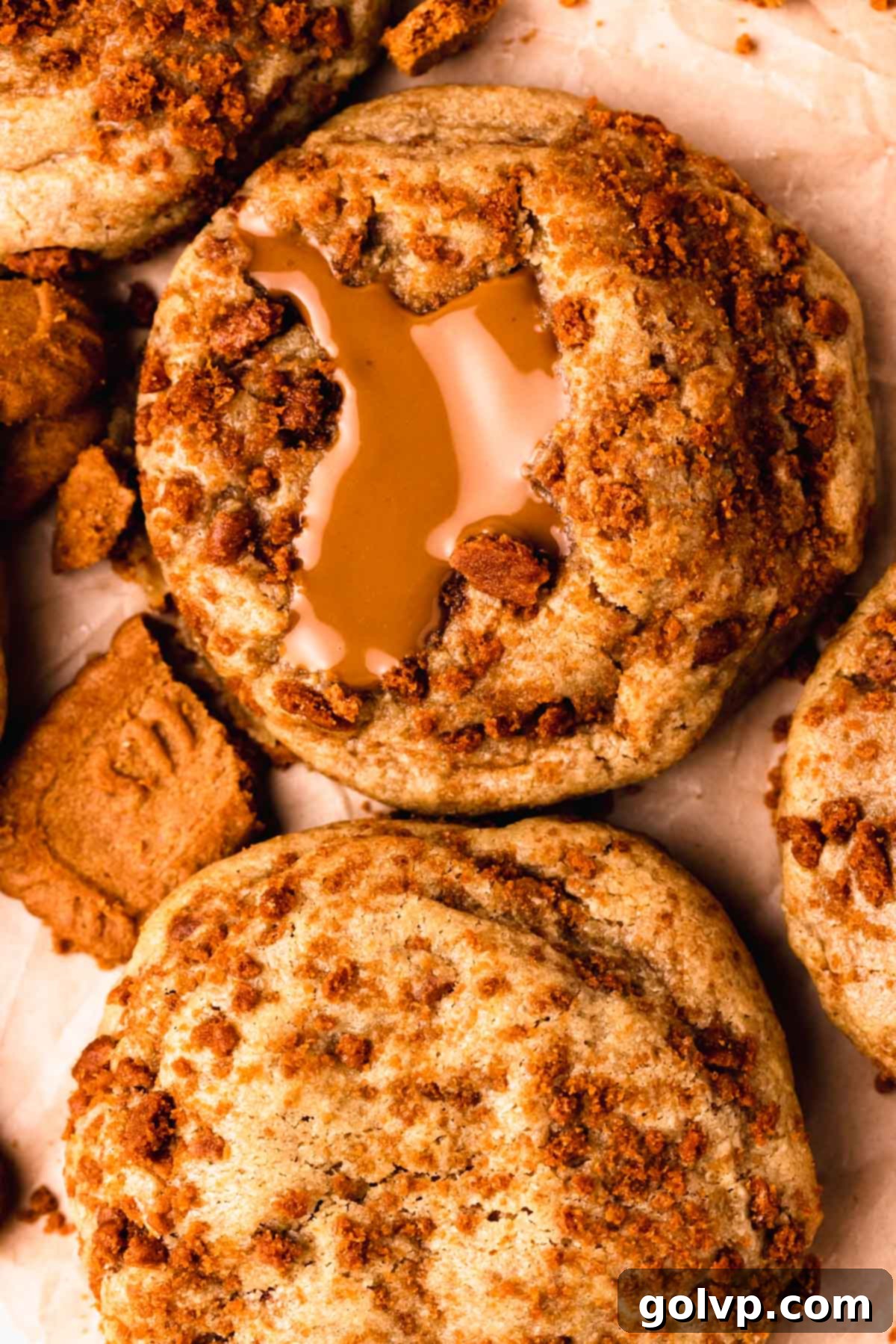
This comprehensive guide will walk you through every step of creating these incredible cookies, from selecting the finest ingredients to mastering the stuffing technique, ensuring that each cookie is a perfect, gooey delight. Get ready to elevate your baking game and impress everyone with these unbelievably delicious, bakery-style Biscoff treasures.
[feast_advanced_jump_to]
🍪 Why You’ll LOVE These Biscoff Stuffed Cookies
There are countless reasons why these Biscoff Stuffed Cookies are destined to become your go-to recipe. They offer a unique blend of textures and an explosion of flavor that sets them apart from your everyday cookie. Here’s what makes them truly special:
- Irresistibly Stuffed: The true magic lies within! Each generous cookie is a treasure trove, filled with a creamy, rich core of melted Biscoff cookie butter and delightful crunch from crushed Biscoff cookies. When served slightly warm, this filling transforms into a luscious, ooey-gooey center that simply melts in your mouth, creating an unparalleled dessert experience.
- Unmatched Softness & Bakery-Style Appeal: Forget thin, crispy cookies. This recipe is designed to yield gloriously thick, wonderfully soft, and delightfully chewy cookies, reminiscent of those decadent treats you’d find at a high-end bakery. Their substantial size and perfect texture make them incredibly satisfying and impressive.
- Surprisingly Easy to Make: Don’t let their impressive appearance fool you! While these Biscoff stuffed cookies look utterly gourmet, the process of making them is surprisingly straightforward and incredibly fun. With clear, step-by-step instructions, even novice bakers can achieve spectacular results, making them perfect for special occasions or a simple weekend baking project.
If your love for cookie butter extends beyond cookies, you absolutely must try my easy Biscoff Cheesecake for a creamy, no-bake delight, or indulge in the layered richness of my Biscoff Cake!
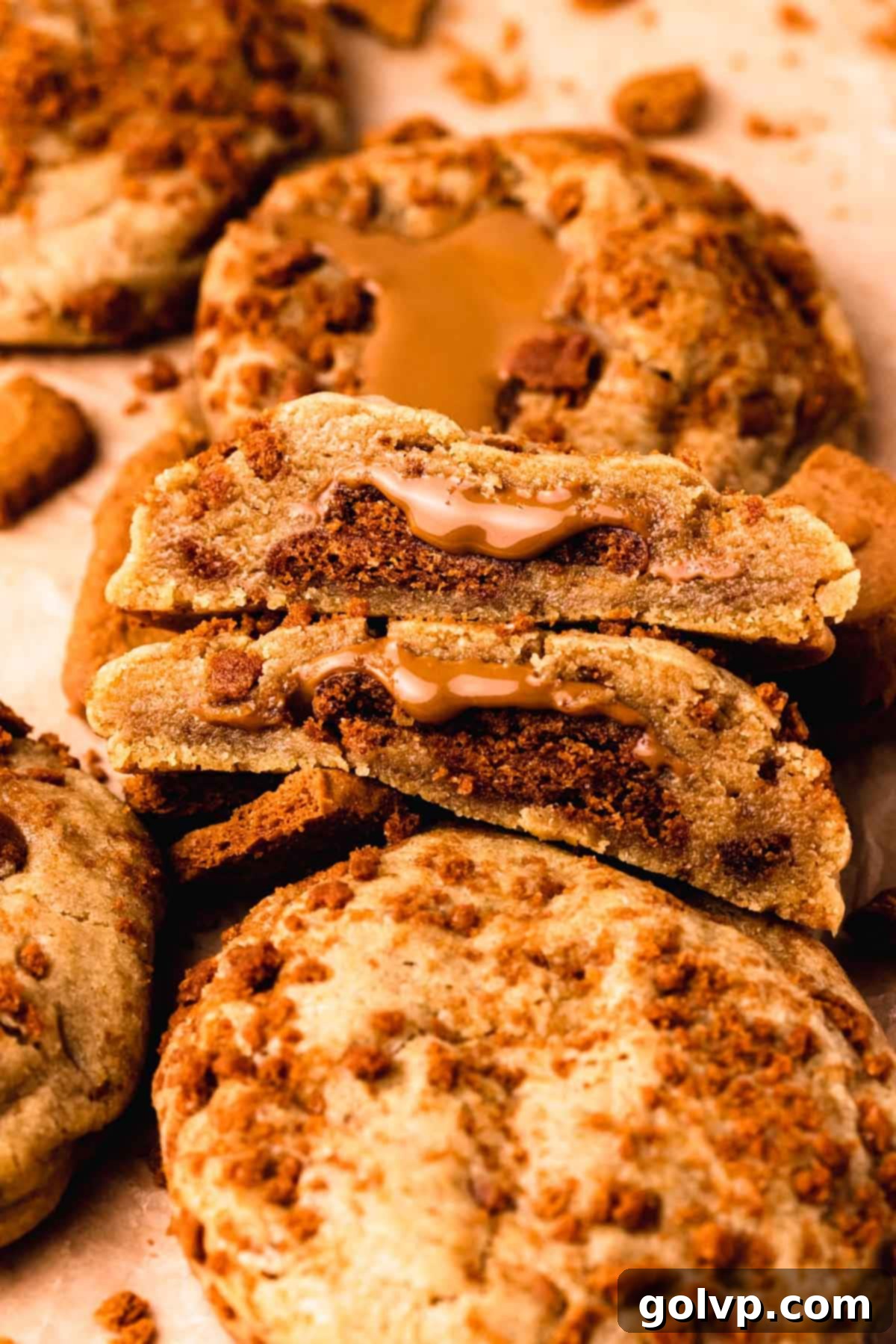
📝 Key Ingredients for Perfect Biscoff Cookies
To achieve the ultimate Biscoff Stuffed Cookies, selecting the right ingredients is crucial. Each component plays a vital role in creating the perfect flavor and texture profile. Read through for all the tips you will need for success!
Full steps and ingredients in recipe card below.
- Biscoff Cookie Butter/Spread: This is the star of our show! Biscoff cookie butter is a velvety spread crafted from finely crushed Biscoff (speculoos) cookies, boasting an unparalleled flavor that combines warming cinnamon, ginger, and deeply caramelized notes. For the best results and a truly decadent filling, I highly recommend using the creamy variety of Biscoff spread. While you could substitute with a generic speculoos cookie spread, please note that Biscoff offers a uniquely rich and intense caramelized taste that truly elevates these cookies.
- Biscoff Cookies: You’ll need these delightful, crunchy biscuits for two purposes: some will be crushed and incorporated into the cookie dough for added texture and flavor, while others will be broken and layered into the filling, providing a lovely textural contrast to the gooey cookie butter. Make sure to have extra on hand for crumbling on top!
- Unsalted Butter: Always opt for good quality, real unsalted butter. The butter flavor truly shines in these cookies, contributing to their richness and tender crumb. If you only have salted butter, it will work, but be mindful of the salt content in your recipe to avoid overly salty cookies. Ensure your butter is softened to room temperature for optimal creaming.
- Brown Sugar: A blend of both brown and granulated sugar is key to achieving that perfect soft and chewy texture. Brown sugar, particularly a lighter or old-fashioned variety, adds a deep, molasses-rich flavor and contributes to the cookies’ moistness. Remember to pack it firmly into your measuring cup to ensure accurate proportions.
- Granulated Sugar: This provides the necessary sweetness and helps with the cookie’s spread and slight crispness around the edges, balancing the chewiness from the brown sugar.
- All-Purpose Flour: Precision is paramount when it comes to flour. For the most accurate and consistent results, I strongly recommend weighing your flour using a kitchen scale. If you don’t have a scale, properly measure by fluffing the flour in its bag, then gently spooning it into a measuring cup without packing it down. Level off the excess with the flat edge of a knife.
- Cornstarch: A secret ingredient for ultimate softness! Cornstarch helps to create incredibly tender cookies, preventing them from becoming tough or overly dense. Arrowroot starch can be used as a substitute if cornstarch is unavailable.
- Baking Powder & Baking Soda: This dynamic duo works together to give our cookies the perfect lift and spread, resulting in those desirable thick, bakery-style cookies.
- Cinnamon: Enhances the classic Biscoff flavor profile, adding an extra layer of warmth and spice to the cookie dough itself.
- Egg and Egg Yolk: Using both a whole egg and an extra egg yolk contributes to the cookies’ richness, chewiness, and moist texture. Ensure they are at room temperature for better emulsion with the butter and sugar mixture.
- Pure Vanilla Extract: A splash of good quality vanilla extract always rounds out and enhances the overall flavor of any baked good.
👩🍳 How to Make These Decadent Biscoff Stuffed Cookies
Crafting these stuffed Biscoff cookies is a delightful process that’s easier than you might think. Follow these detailed steps to achieve perfectly gooey, bakery-style treats every time.
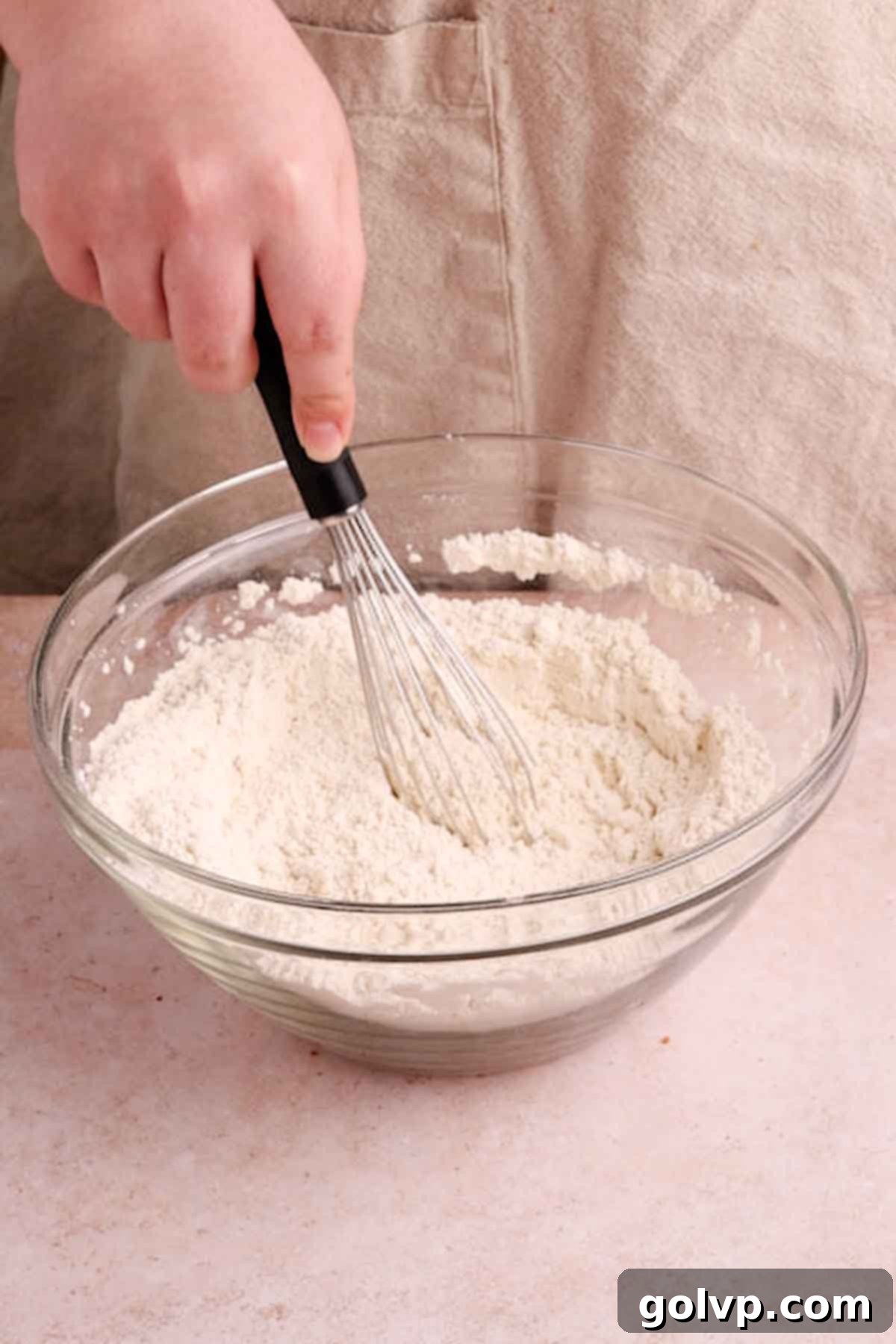
Step 1: Prepare the Dry Ingredients and Biscoff Crumbs. Begin by lining a baking sheet with parchment paper to prepare for chilling your cookie dough. Next, crush about 10 Biscoff cookies into medium-coarse crumbs. You can achieve this using a food processor for a fine, even crumb, or by placing them in a sealed bag and crushing them with a rolling pin for a more rustic texture. In a large bowl, whisk together your sifted all-purpose flour, cornstarch, baking powder, baking soda, and cinnamon until thoroughly combined. Then, gently fold in about ¼ cup of the crushed Biscoff crumbs. Mix everything well and set this bowl aside.
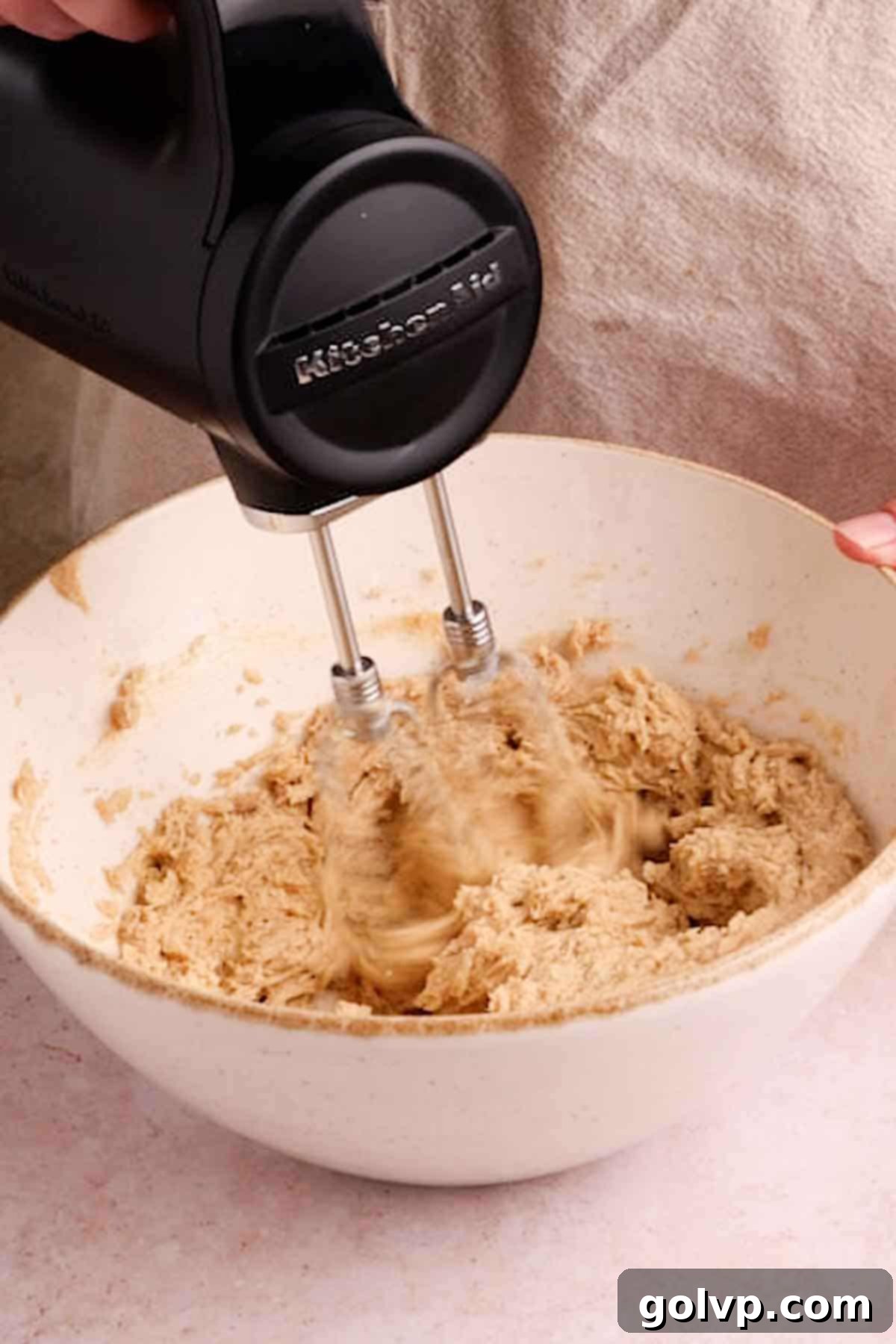
Step 2: Cream Wet Ingredients. In a separate large bowl, or the bowl of a stand mixer fitted with the paddle attachment, beat together the softened butter, packed brown sugar, granulated sugar, and sea salt. Cream these ingredients on medium speed for approximately 2 minutes, or until the mixture becomes wonderfully light, pale, and fluffy. Remember to pause halfway through and scrape down the sides and bottom of the bowl with a spatula to ensure everything is evenly incorporated.
Next, add the large egg, additional egg yolk, and pure vanilla extract to the butter and sugar mixture. Continue beating for about 1 minute until the mixture is incredibly light and fluffy, almost aerated. Again, scrape down the bowl halfway to catch any unmixed ingredients and ensure a smooth, uniform batter.
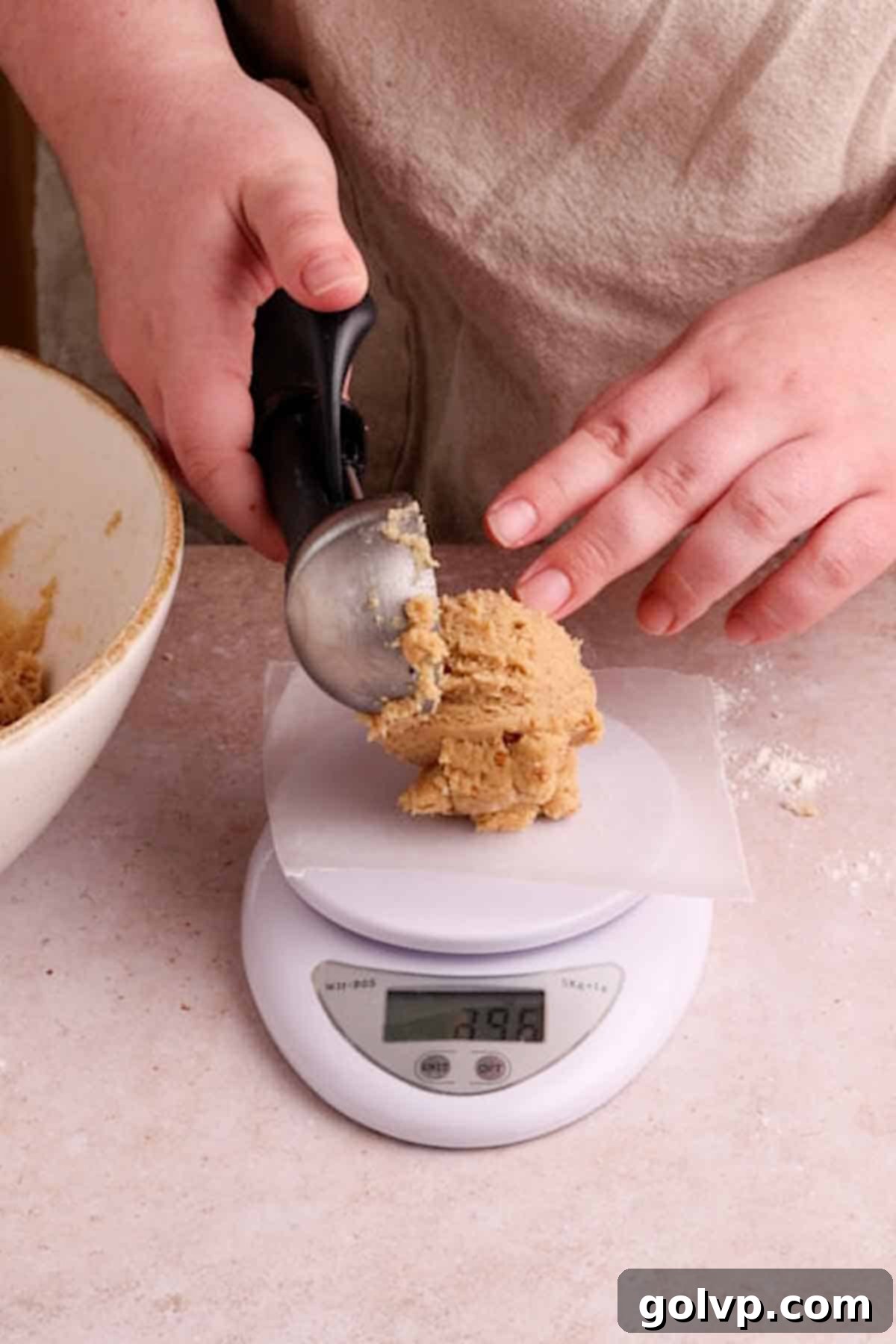
Step 3: Combine and Portion Dough. Gradually add the dry ingredients from Step 1 into the wet ingredients. Mix on low speed until everything just comes together and forms a cohesive cookie dough. Be careful not to overmix; stop as soon as you no longer see any dry streaks of flour. Overmixing can lead to tough cookies. The dough should be soft and pliable.
Now, it’s time to portion your dough for stuffing. For consistent, perfectly sized cookies, weigh out 2-ounce (approximately 56-gram) portions of cookie dough. If you don’t have a kitchen scale, a large, 3-tablespoon capacity cookie scoop can be used to measure out even portions. Place these portions on your prepared parchment-lined baking sheet.
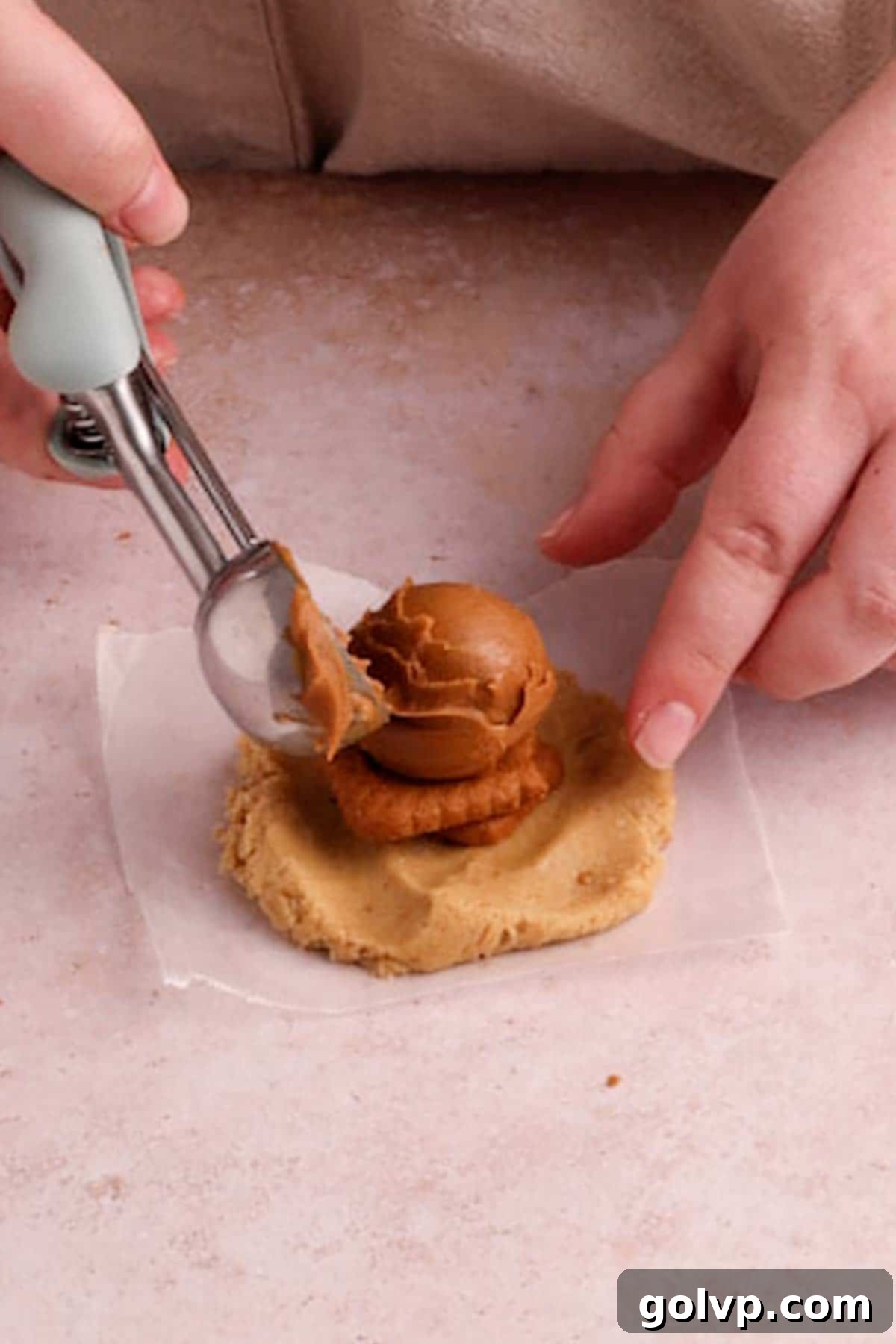
Step 4: The Art of Stuffing. This is where the magic happens! Take two of your portioned cookie dough balls. Gently flatten both portions into even disks with your hands. Break one Biscoff cookie in half. Place each half on top of one of the flattened cookie dough disks, stacking them slightly. Then, using a measuring spoon or a small cookie scoop, dollop a generous, heaping tablespoon of creamy Biscoff cookie butter directly on top of the stacked Biscoff cookie halves.
Carefully place the second disk of flattened cookie dough on top of the filling. Use your fingers to meticulously seal all the edges, working the dough around the filling to completely encapsulate it. Ensure there’s an even layer of cookie dough all the way around, creating a perfectly sealed ball. It’s helpful to keep the cookie butter somewhat centered at the top of the ball, as this helps prevent leakage during baking.
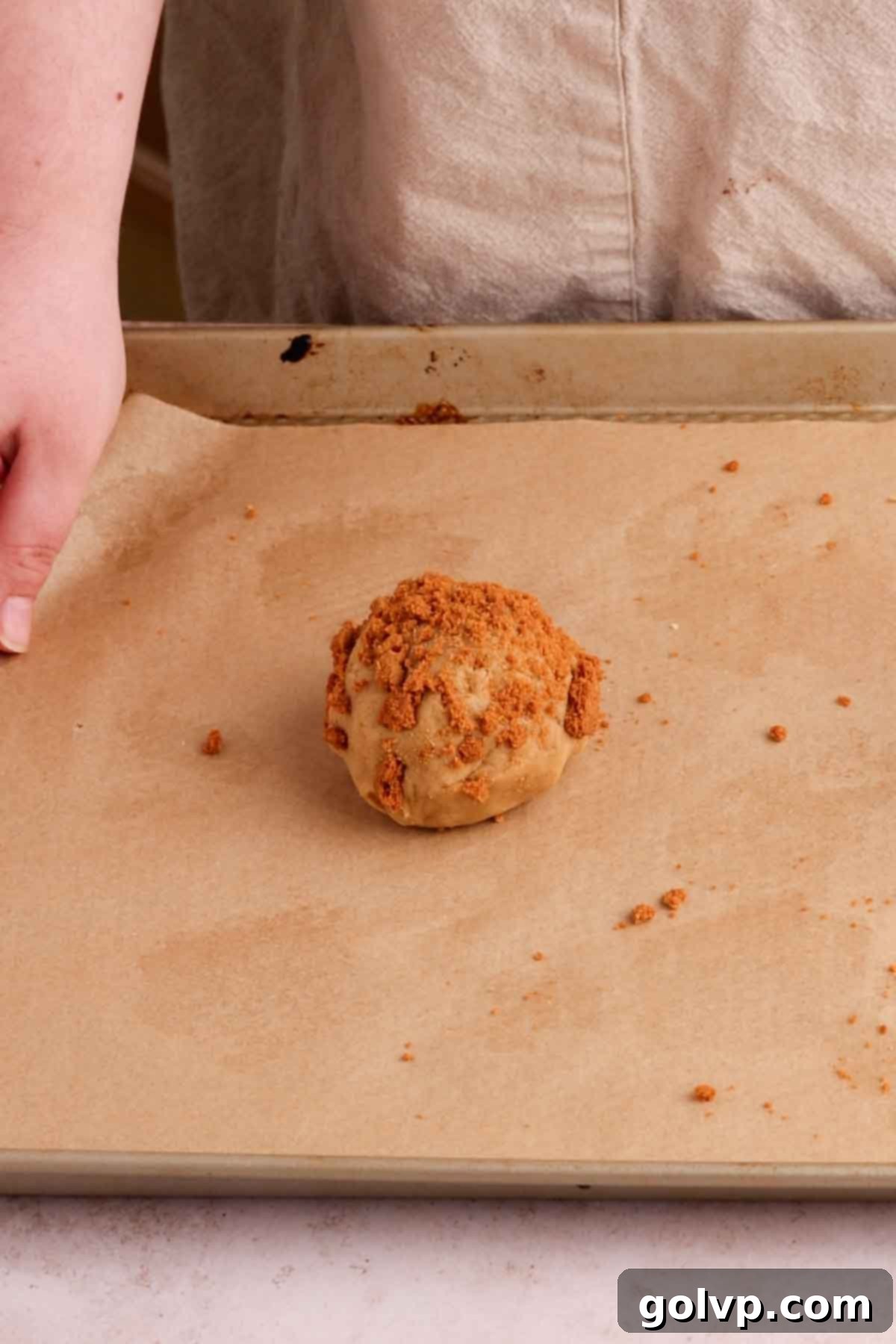
Step 5: Coat and Chill. Pour the remaining crushed Biscoff cookies (that you prepared in Step 1) into a shallow bowl. Take each filled cookie dough ball and gently roll its top outside in the crushed Biscoff, coating it beautifully. This not only adds extra flavor and texture but also creates a stunning visual appeal. Place the coated dough balls back onto your parchment-lined baking sheet as you finish assembling the rest of your cookies.
This next step is absolutely critical for success: chill the cookie dough balls. Place them in the refrigerator for a minimum of 6 hours, or ideally overnight (up to 2 days). If you’re short on time, you can chill them in the freezer for 3 hours. Chilling performs several vital functions: it prevents the cookies from spreading too much during baking, ensures the rich Biscoff cookie butter filling remains perfectly contained, and allows the flavors to deepen and meld, resulting in an even more delicious and satisfying cookie.
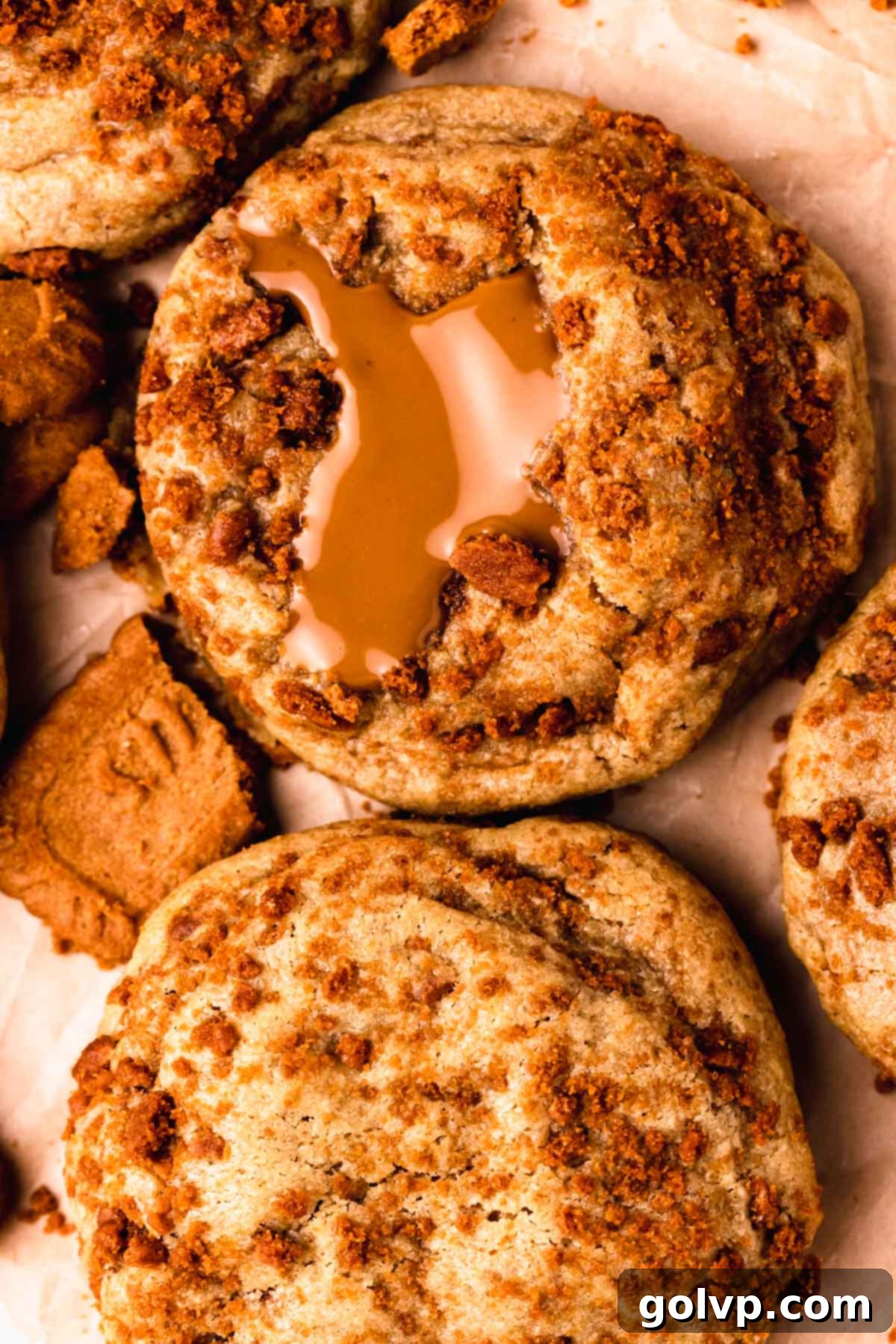
Step 6: Bake to Golden Perfection. When you’re ready to bake, preheat your oven to 375°F (190°C). It’s best to bake these large, stuffed cookies in small batches, typically two at a time, to ensure even baking and proper spread. Carefully place two chilled cookie dough balls on your prepared baking sheet, leaving ample space between them. Bake for 10-13 minutes. The edges should be lightly golden, and the centers should still look slightly soft and gooey. Remember, these cookies continue to cook as they cool.
Once baked, allow the cookies to cool on the baking sheet for a full 10 minutes. This crucial resting period allows them to set properly and prevents them from falling apart when moved. After 10 minutes, carefully transfer them with a wide spatula to a wire cooling rack to cool completely. For an extra indulgent experience, serve these Biscoff stuffed cookies slightly warm – the molten cookie butter filling is absolutely irresistible!
✔️ Expert Tips for Flawless Biscoff Stuffed Cookies
Achieving bakery-quality Biscoff stuffed cookies is easy when you know a few tricks. These expert tips will help you create the perfect texture and prevent any baking mishaps:
- Always Weigh Your Flour: This is arguably the most important tip for consistent baking. Using a kitchen scale to measure flour (and other dry ingredients) ensures you have the exact amount needed. Too much flour can lead to dry, crumbly cookies, while too little can make them spread excessively. Weighing guarantees that perfect dough consistency every single time.
- Opt for Biscoff Brand Cookie Butter: While other speculoos spreads exist, Lotus Biscoff cookie butter is renowned for its superior caramelized cookie flavor and smooth texture. Its distinct taste truly makes these cookies shine and provides the authentic Biscoff experience.
- Weigh Each Cookie Dough Portion Before Stuffing: Precision is key when making stuffed cookies. Weighing each 2-ounce portion of cookie dough ensures that all your cookies are uniform in size. This not only makes them look professionally baked but also guarantees even baking, reducing the risk of the filling bursting out due to uneven dough thickness.
- Do NOT Skip the Chilling Process: We know it’s hard to wait, but chilling the cookie dough is non-negotiable for these stuffed cookies. The extended chill time (6 hours in the fridge or 3 hours in the freezer) allows the butter to solidify, preventing the cookies from spreading too much in the oven. More importantly, it helps the dough firm up around the Biscoff filling, creating a strong barrier that holds the gooey center inside. Chilling also deepens the flavors, making for a richer, more complex cookie.
- Avoid Overbaking at All Costs: Overbaking is the enemy of gooey stuffed cookies. The moment the edges turn lightly golden and the centers still look slightly soft, take them out of the oven. The residual heat from the baking sheet will continue to cook them as they cool. Overbaked cookies will lose their signature soft, gooey texture, and the Biscoff filling is far more likely to leak out if the dough becomes too firm.
- Room Temperature Ingredients: Ensure your butter, egg, and egg yolk are at room temperature. This allows them to emulsify properly with the sugars, creating a smooth, airy batter that results in light and fluffy cookies.
🥄 Make Ahead & Storage Solutions for Biscoff Stuffed Cookies
These Biscoff Stuffed Cookies are just as delightful days after baking, and their dough is perfect for making ahead, making them ideal for meal prep or impromptu treats!
Storage for Baked Cookies: Once baked and fully cooled, your Biscoff stuffed cookies will maintain their freshness and deliciousness for up to 4 days when stored in an airtight container at room temperature. For longer preservation, you can freeze baked cookies in an airtight freezer bag or container for up to 3 months. When ready to enjoy, simply thaw at room temperature or warm slightly in the microwave for a fresh-out-of-the-oven experience.
Make-Ahead Dough: The unbaked, stuffed cookie dough balls are excellent for making ahead. You can prepare them and store them in an airtight bag or container in the refrigerator for up to 2 days. Alternatively, for a longer make-ahead option, freeze them for up to 2 months. When you’re ready to bake from frozen, there’s no need to thaw! Just preheat your oven as usual and add a few extra minutes (typically 3-5 minutes) to the baking time, keeping an eye on them until they’re golden brown and perfectly gooey.
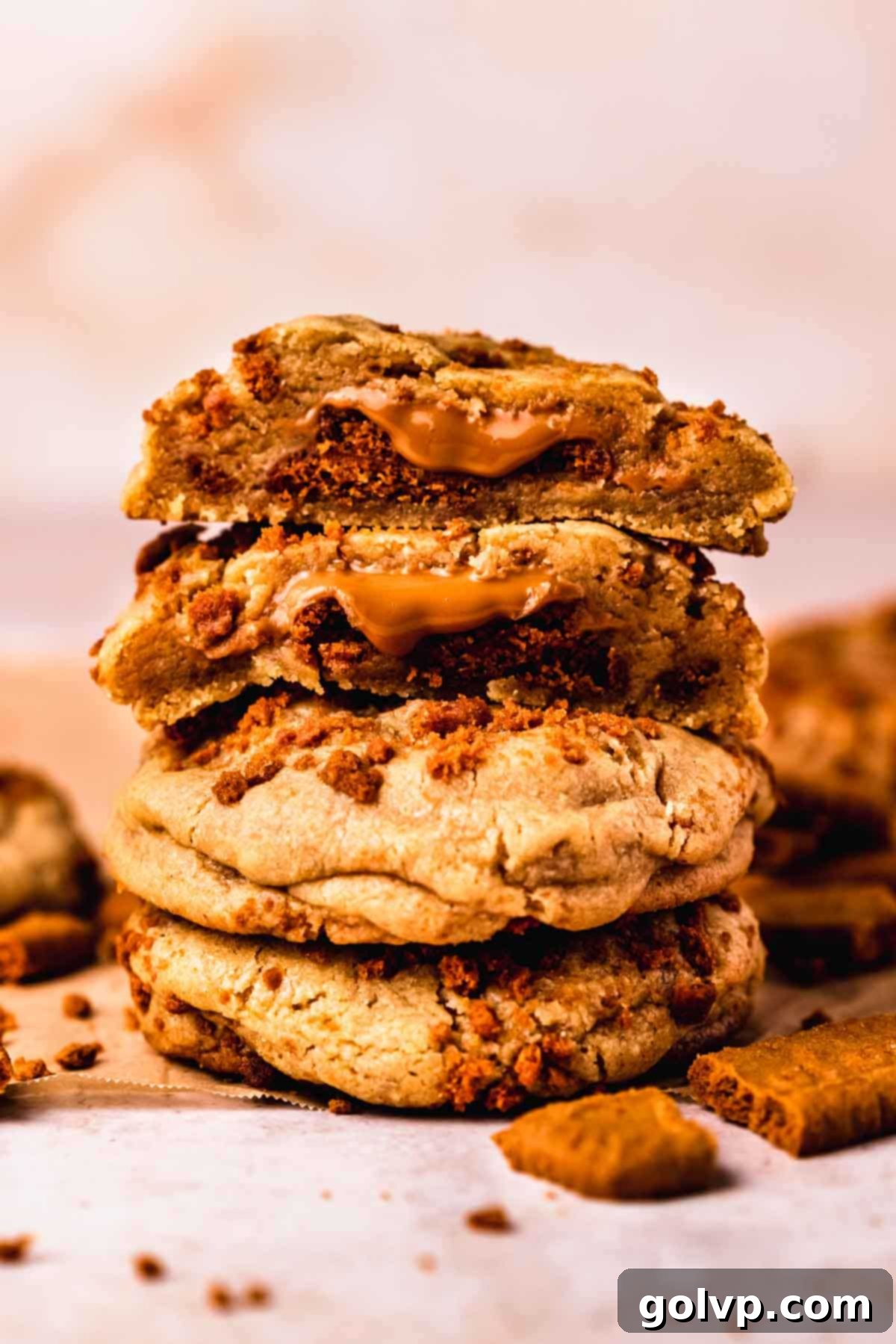
🥫 Where Can I Buy Biscoff Cookie Butter?
Finding Biscoff cookie butter is usually quite easy, given its growing popularity! I often order it conveniently from Amazon, which usually offers a good selection and competitive prices. However, you can typically find it in most major grocery stores. Head to the specialty foods aisle, the peanut butter and spreads section, or even the international foods aisle. If your local supermarket doesn’t carry it, don’t despair! Many European specialty stores are excellent sources, as Biscoff (originally speculoos) is a beloved European invention.
It’s important to note the difference between Biscoff and other speculoos cookie spreads. While both are delicious, Biscoff cookie butter, made by Lotus Bakeries, has a distinctly more pronounced caramelized flavor and often a smoother texture. Generic speculoos spreads can be lovely too, but they sometimes offer a lighter, more delicate spice profile. For this recipe, I highly recommend the authentic Biscoff brand for that signature, deep, caramelized taste. But if speculoos is all you can find, it will still yield delicious results!
🥣 How to Successfully Stuff Your Biscoff Cookies
The key to a perfectly stuffed cookie that doesn’t leak its delicious filling is all in the technique. Don’t worry, it’s simpler than it sounds!
First, precision with your cookie dough portions is crucial. Start by weighing each half of your cookie dough ball – aiming for 2 ounces (approx. 56g) per half. If you don’t have a kitchen scale, a large 3-tablespoon capacity cookie scoop will give you a good approximation for each half. This ensures uniform cookie size and even baking.
Once you have your two equal portions, gently flatten each half with your hands into a disk. Next, take a Biscoff cookie and break it in half. Stack these two halves neatly on top of one of your flattened cookie rounds. Then, carefully scoop a heaping tablespoon of Biscoff cookie butter and place it on top of the stacked Biscoff cookie pieces. This layering ensures both texture and that irresistible gooey center.
Now, gently place the second flattened cookie dough round directly on top of the filling. Work quickly and carefully, using your fingers to meticulously seal the edges of the two dough disks together. Pinch and smooth the dough all the way around, ensuring there are no gaps for the cookie butter to escape during baking. Reshape the entire assembly into a neat ball, making sure the Biscoff cookie butter filling remains enclosed and ideally somewhat centered at the top of the cookie for the best presentation after baking.
Finally, roll the top of your newly stuffed cookie dough ball in the crushed Biscoff crumbs you prepared earlier. This adds an extra layer of flavor and a beautiful finish. Set it aside on your parchment-lined baking sheet and repeat the process for the remaining cookies. Remember, proper sealing and chilling are your best friends here!
If you’re looking for more delightful stuffed cookie recipes, be sure to check out these amazing options: Blueberry Cheesecake Cookies and Strawberry Cheesecake Cookies.
📖 Recipe FAQs
Got questions about baking these delicious Biscoff stuffed cookies? We’ve got answers to help you achieve perfect results!
Absolutely! If you prefer a simpler, yet equally delicious, Biscoff cookie, you can definitely make them without the stuffing. Just roll the dough into 2-tablespoon sized balls, roll the tops in crushed Biscoff cookies for that signature look, and bake. Be mindful of the baking time, as unstuffed cookies will likely be ready sooner – typically around 8-10 minutes. You can drizzle them with extra cookie butter after baking or enjoy them as is!
There are a few common culprits if your delicious Biscoff filling is escaping. The most important steps to prevent leakage are: first, ensure you thoroughly seal the edges of the two cookie dough disks around the filling; second, do not skip the crucial chilling step (this helps the dough firm up and contain the filling); and third, avoid overbaking. Overbaking can cause the dough to crack or the filling to become too hot and seep out. Follow these tips, and your filling should stay perfectly contained.
The higher oven temperature of 375°F (190°C) is strategic for these stuffed cookies. It helps to “shock” the cookie dough, causing the edges to set quickly and preventing excessive spreading before the filling can fully melt and become liquid. This rapid initial bake helps ensure the filling remains encased within the cookie, creating that perfect gooey center without leakage. For best results, I always recommend using an oven thermometer to verify your oven is reaching and maintaining the correct temperature.
Yes, absolutely! Measuring the cookie dough portions precisely is incredibly important, especially for stuffed cookies. This ensures that all your cookies are of uniform size, which is vital for even baking. I’ve extensively tested this recipe with specific dough sizes to ensure optimal baking time and temperature, guaranteeing that the cookies hold their structure and the filling doesn’t burst. If you don’t have a digital kitchen scale, a 3-tablespoon cookie scoop is a reliable alternative to get consistent portions.
Yes, yes, YES! I know the waiting can be tough, but chilling the cookie dough is perhaps the most critical step for success with these stuffed Biscoff cookies. This essential step ensures the cookies remain soft and chewy, prevents them from spreading too much during baking, and is key to keeping that luscious Biscoff filling perfectly contained in the middle. Beyond structural integrity, chilling also allows the flavors in the dough to meld and deepen, resulting in a far more delicious and nuanced cookie. It’s truly a non-negotiable step for a smooth and successful baking process!
🍪 More Irresistible Biscoff & Stuffed Cookie Recipes
If you’ve fallen in love with the caramelized spiced goodness of Biscoff or enjoy the delightful surprise of a stuffed cookie, you’re in luck! Here are some more fantastic recipes to explore from Flouring Kitchen:
- Biscoff Cheesecake
- Biscoff Cake
- Small Batch Chocolate Chip Cookies
- Strawberry Cheesecake Cookies
Did you try this amazing Biscoff stuffed cookie recipe? I would absolutely love to hear your thoughts! Please take a moment to rate this recipe and share your baking experience in the comments below. If you share your delicious creations on Instagram, don’t forget to tag @flouringkitchen so I can see your masterpieces! For more incredible recipe ideas and baking inspiration, be sure to follow me on Pinterest.
📖 Recipe
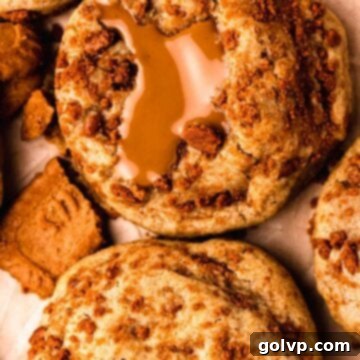
Biscoff Stuffed Cookie Butter Cookies
Mary
Pin Recipe
Shop Ingredients
Equipment
-
Digital Kitchen Scale
-
Large Baking Sheet
-
Electric Mixer (Stand or Handheld)
Ingredients
- 2 ½ cups all-purpose flour (300g, spooned and leveled)
- ½ tablespoon cornstarch (or arrowroot starch)
- ½ teaspoon baking powder
- ¼ teaspoon baking soda
- 1 teaspoon ground cinnamon
- 1 cup unsalted butter (softened)
- ¾ cup light brown sugar (packed)
- ¼ cup granulated sugar
- ¼ teaspoon fine sea salt
- 1 large egg (room temperature)
- 1 large egg yolk (room temperature)
- 1 tablespoon pure vanilla extract
- ½ cup creamy Biscoff cookie butter
- 16 Biscoff cookies (approximately half a pack)
Shop Ingredients on Jupiter
Instructions
-
Line a baking sheet with a piece of parchment paper. Crush 10 Biscoff cookies into medium-coarse crumbs using a food processor or by placing them into a sturdy bag and crushing with a rolling pin. Set aside.16 biscoff cookies (used for crushing and stuffing)
-
In a large bowl, combine the sifted all-purpose flour, cornstarch, baking powder, baking soda, and ground cinnamon. Add ¼ cup of the crushed Biscoff cookies. Mix all dry ingredients well with a whisk and set this bowl aside.2 ½ cups all-purpose flour, ½ tablespoon cornstarch, ½ teaspoon baking powder, ¼ teaspoon baking soda, 1 teaspoon ground cinnamon
-
In a separate large bowl or the bowl of a stand mixer, beat together the softened unsalted butter, packed light brown sugar, granulated sugar, and fine sea salt. Beat on medium speed until the mixture is light and fluffy (approximately 2 minutes), making sure to scrape down the bowl halfway through.1 cup unsalted butter, ¾ cup light brown sugar, ¼ cup granulated sugar, ¼ teaspoon fine sea salt
-
Add the large egg, egg yolk, and pure vanilla extract to the butter and sugar mixture. Beat until the mixture is very light and fluffy, for about 1 minute, scraping down the bowl halfway to ensure all ingredients are well combined.1 large egg, 1 large egg yolk, 1 tablespoon pure vanilla extract
-
Gradually add the dry ingredients into the wet ingredients, mixing on low speed until everything just comes together to form a cohesive dough. Stop mixing as soon as no more dry streaks of flour remain in the bowl to avoid overmixing.
-
Weigh out 2-ounce (approx. 56g) portions of cookie dough. For consistent results without a scale, use a large 3-tablespoon capacity cookie scoop to measure out your portions.
-
Take two portions of cookie dough and flatten both into even disks with your hands. Break one Biscoff cookie in half and stack each half on top of one of the flattened cookie dough disks. Scoop a heaping tablespoon of creamy Biscoff cookie butter on top of the stacked Biscoff cookies. Place the second disk of cookie dough on top and carefully seal all the edges with your hands, creating an even layer of cookie dough around the entire filling. Ensure the cookie butter remains at the top/center of the cookie ball.½ cup creamy Biscoff cookie butter, 16 biscoff cookies
-
Place the remaining crushed Biscoff cookies into a shallow bowl. Roll the top outside of each filled cookie dough ball in the crushed Biscoff to coat. Set aside onto the parchment-lined baking sheet as you assemble the rest of the cookies.
-
Crucial Step: Chill the cookie dough balls in the fridge for a minimum of 6 hours, or ideally overnight. For a quicker chill, place them in the freezer for 3 hours. This essential step prevents the cookies from spreading too much, helps the Biscoff filling from oozing out, and allows the flavors to develop, resulting in a more flavorful cookie.
-
Preheat your oven to 375°F (190°C). Bake only two cookies at a time for 10-13 minutes. The edges should be lightly golden, and the centers should still appear soft and slightly underbaked. Let the cookies cool on the baking sheet for a full 10 minutes before carefully transferring them to a wire cooling rack with a wide spatula to cool completely. Serve the Biscoff stuffed cookies slightly warm for the ultimate gooey cookie butter filling experience.
Video
Notes
Storage: Once completely cooled, store the cookies in an airtight container at room temperature for up to 4 days. For longer storage, freeze them in an airtight freezer bag or container for up to 3 months. Thaw at room temperature or gently reheat for a fresh taste.
Make Ahead: You can prepare the stuffed cookie dough balls in advance! Refrigerate them in an airtight bag or container for up to 2 days, or freeze for up to 2 months. When ready to bake, place frozen dough balls directly on the baking sheet and add a few extra minutes (usually 3-5 mins) to the baking time.
Tips for Success:
- For consistent results, always weigh your flour using a digital kitchen scale.
- Use authentic Biscoff brand cookie butter for the best flavor.
- Weigh each cookie dough portion before stuffing to ensure even baking and prevent filling leakage.
- Chilling the cookie dough is absolutely essential for soft cookies that hold their filling.
- Do not overbake the cookies! They should still look slightly soft in the center when removed from the oven.
Cornstarch Alternatives: If you don’t have cornstarch, you can substitute it with an equal amount of arrowroot starch or rice flour. Alternatively, you can double the amount of all-purpose flour in the recipe, though this may result in a slightly less tender cookie.
